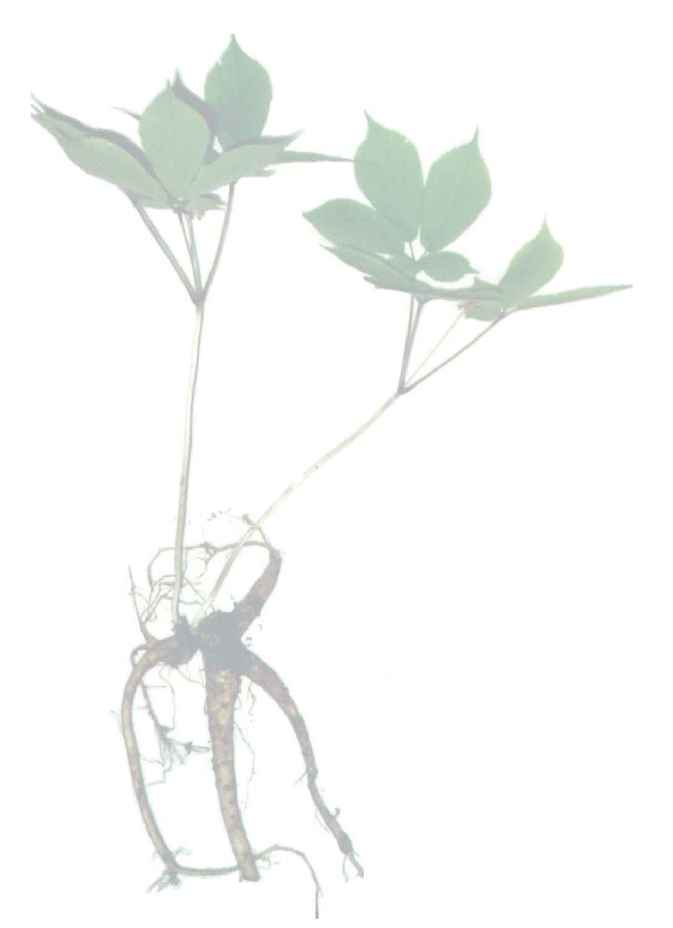
W
ild, native ginseng is a
mysterious plant.
And its very fragile nature and
rarity parallel its mystery.
But it is not as rare in the Southern
Tier of New York state and the
Northern Tier counties of Pa. as one
might think. And not as scarce as it
used to be.
So wait a minute before you send
the chainsaws into the woods.
Experienced wild-crafters know
how to find it. They know what
ginseng looks like. And they can
make a lot of money digging its
roots and selling them.
Ginseng has come back. And its
roots are selling for around $500
per pound. Mature ginseng roots are
about the size of a small baby
carrot. And if a good patch of old,
mature plants are found with roots
weighing over an ounce, it quickly
adds up.
A knapsack full of root will buy a
lot of Christmas presents.
But why is ginseng being
discovered in the upland woodlands
now?
Simple. It's the forest canopy.
Ginseng has rigid requirements for
optimal growth. First and foremost
is light. Even cultivated ginseng,
that which is grown to feed the
current popular culture's craving for
stylish and holistic supplements,
needs shade.
It needs a lot of shade.
So landowners should be careful not
to cut their hardwood woodlot too
hastily. They may have a fortune of
ginseng nestled at the base of that
stand of maples or oak and not even
know it.
Ginseng has come back because the
forests have come back. Deer,
turkey, bear and beaver have all
returned to populations greater than
ever. It's easy to forget that New
York state had its first whitetail deer
season just 60 years ago (1939).
Before that there were too few
whitetails to hold a hunting season.
Where there are stretches of woods
now were just brushlots and fields
75 years ago.
New Yorkers had their first turkey
season in the mid-sixties. Before
then, even seeing a wild turkey was
a rarity. And as the trees came back
from the ravages of the first half of
the 20th century, so have the plants
of the deep woodlands, among them
-- ginseng.
Ginseng is often broken down to
three categories: Wild, wild-
cultivated and cultivated. By far and
away the most valuable is the wild,
natural
ginseng.
Cornell
University's Horticulture school has
concluded a recent scientific study,
the first of its kind, analyzing and
comparing
the
various
gensenocides, or the active
ingredients in ginseng.
And they have found that there are
vast differences from one ginseng
root to another.
People are growing ginseng under
their trees by planting seeds and
transplanting small plants. It's
money in the bank. As the plants
mature and grow larger roots each
year, they increase in value. Wild-
cultivated ginseng may not fetch the
highest price on the market that
wild ginseng does, but is much
more valuable that then third type,
-- cultivated ginseng.
Enterprising farmers have turned
acres into ginseng production to
feed the current craze. And when
there is not a natural forest canopy,
they construct coverings over the
elegant
little
shade-loving
herbaceous plants.
Part of the Cornell study has
determined that different strains of
ginseng possess varying amounts of
ginsenocides. And those rare wild
plants contain the most.
Just because a large rovot and plant
can be grown in a few years under
artificial conditions (in a field under
a covering) doesn't mean the plant
will be more valuable than the
small, wild root. The wild plant
contains the chemicals so sought
after by the Asian market. And they
will pay astronomical prices for an
individual root.
It isn't the size of the root, but the
magic in it.
And dealers can immediately spot
the difference.
Unbeknown to a lot of people, wild
ginseng collecting is regulated by
state governments.
In New York state, wild-crafters or
collectors are only allowed to
harvest wild plants for two months,
from September 1 to November 1.
Currently, in New York state, a
license is not required to dig it. But
dealers, anyone who trades or sells
the roots or plants, are required by
law to purchase a license from the
DEC and maintain written records.
There are a number of books and
volumes of information written on
the subject of this fascinating and
magical plant. There's a lot to it.
So before you hastily take to the
woods to hunt 'sang or rev up the
chainsaws, it would be wise to learn
about "the man of the woods," as
the mature root is called for its
unique shape.
Some of the roots under the proud
little perennials may be 20, 30 or
even 50 years old and very, very
valuable.
Oak Duke, publisher of the
Daily Reporter writes a weekly
column, appearing Monday on The
Outdoors Page.
Before you cut
your woodlot,
check out the
ginseng
By: Oak Duke
